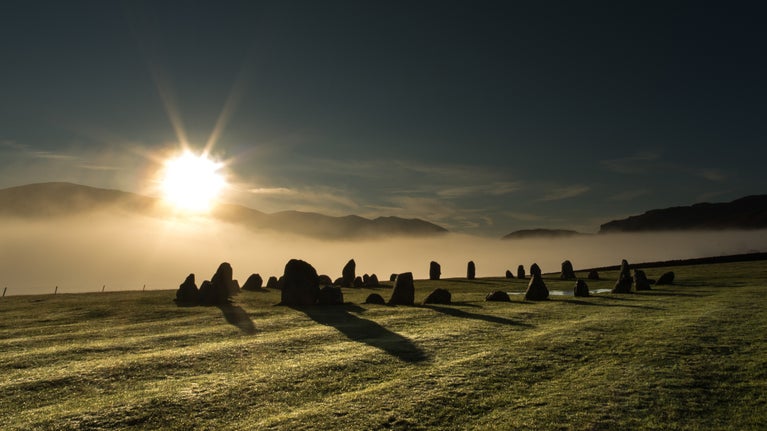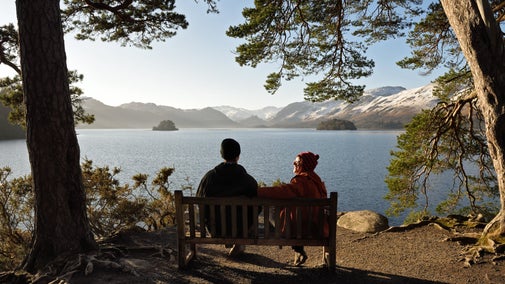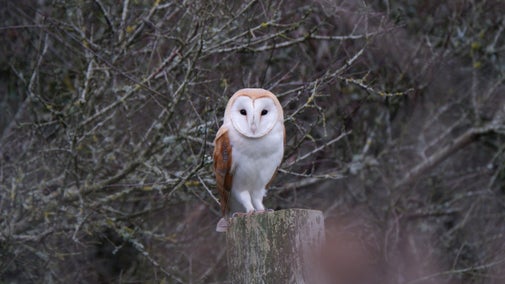
Discover more at Borrowdale and Derwent Water
Find out how to get to Borrowdale and Derwent Water, where to park, the things to see and do and more.

The Bowder Stone, the Borrowdale Yews and Castlerigg stone circle have stood largely unchanging, watching the landscape of the Borrowdale valley change around them. Discover the history of these ancient residents of the Lake District.
It's easy to look at the landscape of the Lake District and think that it's been unchanged for hundreds of years, but landscape change has actually been dramatic over the past 200 years.
- Harvey Wilkinson, National Trust curator
Did it fall from the crags above? Was it carried by a glacier? Famous writers and artists have their theories.
To see the theories in the gallery above come to life, artist and film maker John Hamlett was commissioned to create three short animations.
Now it stands just as impassively while boulderers cling to its overhang, creating routes with incredible names like 'Picnic Sarcastic'.
The regenerated woodland surrounding it has been designated a Site of Special Scientific Interest because it's one of the last remaining fragments of the Atlantic oak wood habitat.
It sparks a conversation about the landscapes in the Lake District, and what the concept of an evolving masterpiece means for the future of this unique and inspirational place.

Surrounded by the fells of Skiddaw and Blencathra to its north and Castlerigg Fell, High Rigg and Clough Head to its south, this ring of 38 stones, set within a ring of mountains, has stood at Castlerigg for about 4,500 years since it was created by Neolithic farming communities.
Archaeological studies suggest that Castlerigg is an early example of a stone circle, as it is not perfectly round; one side is slightly flattened.
The square enclosure within the circle appears to have been added at a later date, suggesting that Castlerigg was used by many generations of people over a long time period.

Not far from Seatoller, on the way to Seathwaite, stand some old friends of William Wordsworth: the Borrowdale Yews. They are thought to be more than 1,500 years old.
- William Wordsworth, Yew-Trees, 1803
Not too long after Wordsworth wrote about the ‘fraternal four’, four became three when one was uprooted by a storm in 1866, and various storms over the years have done their best to ravage and scar the remaining trees. Yet the yews remain resilient, slowly contorting and re-growing to live on beyond us all.
North Lakes Woodlands Ranger Maurice Pankhurst and other experts have studied the yews and have been able to determine that not only are they over 1,500 years old, but also that the remaining three trees actually only represent two individuals - two of them are genetically identical.

Find out how to get to Borrowdale and Derwent Water, where to park, the things to see and do and more.
Discover the top things to see and do during your visit, including scenic walks, ancient woodlands, far-reaching views and famous Lakeland highlights such as the Bowder Stone

Take in the views from Friar’s Crag and visit historic sculptures on a lakeside walk around Derwent Water or set off from Keswick to explore the surrounding woodlands and fells.

Discover the internationally significant ‘Atlantic oakwoods’ and Derwent Water which support a variety of rare species of plants and animals, including the red squirrel and vendace.

Derwent Island and House is currently closed to visitors, but the site is still an interesting element of the Borrowdale landscape. Find out all you need to know about the history of the island and the many owners of the house.

Learn about people from the past, discover remarkable works of art and brush up on your knowledge of architecture and gardens.
